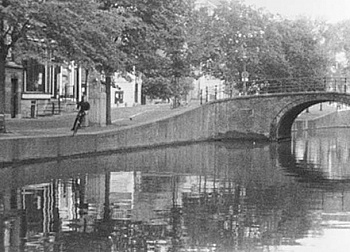
Marine Hugonnier
#Photographe
- Exposition
Exposition : Landscape in Motion
 The advent of the "Anthropocene period," in which mankind represents the earth’s determining force, has opened a new era in which we can hardly imagine looking at a landscape without the ‘eye’ of the camera.
The first photographs taken from space in the 1960s made the limitations of the Earth’s surface vividly clear, altering how we understand our interaction with land and landscape.
Landscape in Motion explores how our relationship to landscape has changed following pioneering works from the 1960s and how film has played an essential role in this process.
This groundbreaking exhibition includes work by leading international photographers and film artists: Darren Almond, Rosa Barba, James Benning, Ursula Biemann, Lucius Burckhardt, Leo Calice and Gerhard Treml, Center for Land Use I...
The advent of the "Anthropocene period," in which mankind represents the earth’s determining force, has opened a new era in which we can hardly imagine looking at a landscape without the ‘eye’ of the camera.
The first photographs taken from space in the 1960s made the limitations of the Earth’s surface vividly clear, altering how we understand our interaction with land and landscape.
Landscape in Motion explores how our relationship to landscape has changed following pioneering works from the 1960s and how film has played an essential role in this process.
This groundbreaking exhibition includes work by leading international photographers and film artists: Darren Almond, Rosa Barba, James Benning, Ursula Biemann, Lucius Burckhardt, Leo Calice and Gerhard Treml, Center for Land Use I... - Exposition
There is no(w) romanticism curated by Lilou Vidal
 Le Romantisme est-il mort? On constate dans l’art contemporain et conceptuel la persistance d’une certaine forme de Romantisme. Cette persistance ne viendrait elle pas justement du fondement intrinsèque de l’être, dont la dualité entre raison et émotion serait génératrice de mélancolie ? La négation et le reniement de cette inclination naturelle au romantisme, n’auraient ils pas réactualisé son sens et son existence ?
Historiquement le Romantisme s’est affirmé comme une critique rhétorique d’une idéologie basée sur la logique et les contraintes matérielles au XIXème siècle, époque de l’industrialisation et de la naissance de la société de m...
Le Romantisme est-il mort? On constate dans l’art contemporain et conceptuel la persistance d’une certaine forme de Romantisme. Cette persistance ne viendrait elle pas justement du fondement intrinsèque de l’être, dont la dualité entre raison et émotion serait génératrice de mélancolie ? La négation et le reniement de cette inclination naturelle au romantisme, n’auraient ils pas réactualisé son sens et son existence ?
Historiquement le Romantisme s’est affirmé comme une critique rhétorique d’une idéologie basée sur la logique et les contraintes matérielles au XIXème siècle, époque de l’industrialisation et de la naissance de la société de m... - Exposition
Then the work takes place On the Paradigm of the Conceptual in Contemporary Photography
 Curators: Maren Lübbke-Tidow (D) und Reinhard Braun (A)
First the artist defines meaning, then the work takes place.
Dan Graham, 1972
Contemporary conceptual art has, in recent years, been experiencing a cyclical upturn. Accordingly, in 2006 Camera Austria, with the exhibition "First the artist defines meaning", presented works by a younger generation of artists who were founding their work on conceptual reflections. Evident here was a fundamental relationship of ambivalence – between image and idea, between the visible and its representation, between methods and meaning – that invited more intensive reflection on this ambivalent relationship as explored through the current (follow-up) project. After all, the title "Then the work takes place" phrases the completion of Dan Gra...
Curators: Maren Lübbke-Tidow (D) und Reinhard Braun (A)
First the artist defines meaning, then the work takes place.
Dan Graham, 1972
Contemporary conceptual art has, in recent years, been experiencing a cyclical upturn. Accordingly, in 2006 Camera Austria, with the exhibition "First the artist defines meaning", presented works by a younger generation of artists who were founding their work on conceptual reflections. Evident here was a fundamental relationship of ambivalence – between image and idea, between the visible and its representation, between methods and meaning – that invited more intensive reflection on this ambivalent relationship as explored through the current (follow-up) project. After all, the title "Then the work takes place" phrases the completion of Dan Gra...
Modifier l'image
 The advent of the "Anthropocene period," in which mankind represents the earth’s determining force, has opened a new era in which we can hardly imagine looking at a landscape without the ‘eye’ of the camera.
The first photographs taken from space in the 1960s made the limitations of the Earth’s surface vividly clear, altering how we understand our interaction with land and landscape.
Landscape in Motion explores how our relationship to landscape has changed following pioneering works from the 1960s and how film has played an essential role in this process.
This groundbreaking exhibition includes work by leading international photographers and film artists: Darren Almond, Rosa Barba, James Benning, Ursula Biemann, Lucius Burckhardt, Leo Calice and Gerhard Treml, Center for Land Use I...
The advent of the "Anthropocene period," in which mankind represents the earth’s determining force, has opened a new era in which we can hardly imagine looking at a landscape without the ‘eye’ of the camera.
The first photographs taken from space in the 1960s made the limitations of the Earth’s surface vividly clear, altering how we understand our interaction with land and landscape.
Landscape in Motion explores how our relationship to landscape has changed following pioneering works from the 1960s and how film has played an essential role in this process.
This groundbreaking exhibition includes work by leading international photographers and film artists: Darren Almond, Rosa Barba, James Benning, Ursula Biemann, Lucius Burckhardt, Leo Calice and Gerhard Treml, Center for Land Use I... Le Romantisme est-il mort? On constate dans l’art contemporain et conceptuel la persistance d’une certaine forme de Romantisme. Cette persistance ne viendrait elle pas justement du fondement intrinsèque de l’être, dont la dualité entre raison et émotion serait génératrice de mélancolie ? La négation et le reniement de cette inclination naturelle au romantisme, n’auraient ils pas réactualisé son sens et son existence ?
Historiquement le Romantisme s’est affirmé comme une critique rhétorique d’une idéologie basée sur la logique et les contraintes matérielles au XIXème siècle, époque de l’industrialisation et de la naissance de la société de m...
Le Romantisme est-il mort? On constate dans l’art contemporain et conceptuel la persistance d’une certaine forme de Romantisme. Cette persistance ne viendrait elle pas justement du fondement intrinsèque de l’être, dont la dualité entre raison et émotion serait génératrice de mélancolie ? La négation et le reniement de cette inclination naturelle au romantisme, n’auraient ils pas réactualisé son sens et son existence ?
Historiquement le Romantisme s’est affirmé comme une critique rhétorique d’une idéologie basée sur la logique et les contraintes matérielles au XIXème siècle, époque de l’industrialisation et de la naissance de la société de m... Curators: Maren Lübbke-Tidow (D) und Reinhard Braun (A)
First the artist defines meaning, then the work takes place.
Dan Graham, 1972
Contemporary conceptual art has, in recent years, been experiencing a cyclical upturn. Accordingly, in 2006 Camera Austria, with the exhibition "First the artist defines meaning", presented works by a younger generation of artists who were founding their work on conceptual reflections. Evident here was a fundamental relationship of ambivalence – between image and idea, between the visible and its representation, between methods and meaning – that invited more intensive reflection on this ambivalent relationship as explored through the current (follow-up) project. After all, the title "Then the work takes place" phrases the completion of Dan Gra...
Curators: Maren Lübbke-Tidow (D) und Reinhard Braun (A)
First the artist defines meaning, then the work takes place.
Dan Graham, 1972
Contemporary conceptual art has, in recent years, been experiencing a cyclical upturn. Accordingly, in 2006 Camera Austria, with the exhibition "First the artist defines meaning", presented works by a younger generation of artists who were founding their work on conceptual reflections. Evident here was a fundamental relationship of ambivalence – between image and idea, between the visible and its representation, between methods and meaning – that invited more intensive reflection on this ambivalent relationship as explored through the current (follow-up) project. After all, the title "Then the work takes place" phrases the completion of Dan Gra...